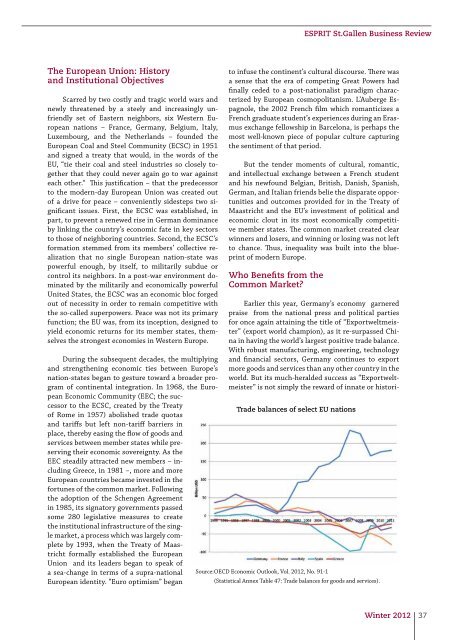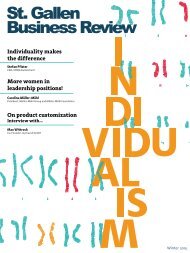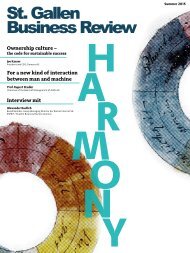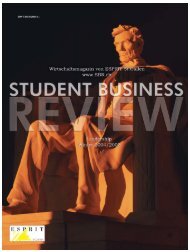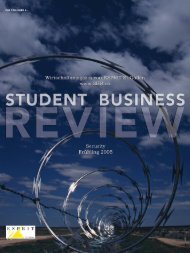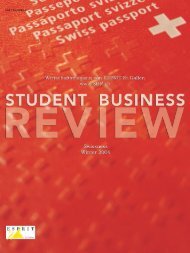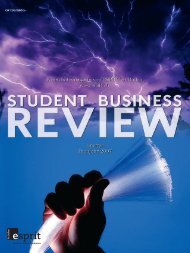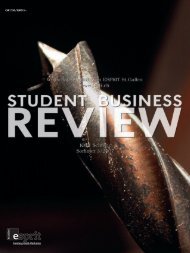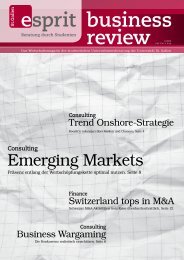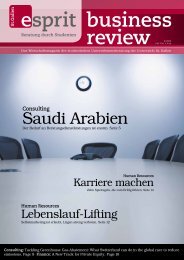Sicherheit und Risiko
St.Gallen Business Review Winter 2012
St.Gallen Business Review
Winter 2012
Sie wollen auch ein ePaper? Erhöhen Sie die Reichweite Ihrer Titel.
YUMPU macht aus Druck-PDFs automatisch weboptimierte ePaper, die Google liebt.
ESPRIT St.Gallen Business Review<br />
The European Union: History<br />
and Institutional Objectives<br />
Scarred by two costly and tragic world wars and<br />
newly threatened by a steely and increasingly unfriendly<br />
set of Eastern neighbors, six Western European<br />
nations – France, Germany, Belgium, Italy,<br />
Luxembourg, and the Netherlands – fo<strong>und</strong>ed the<br />
European Coal and Steel Community (ECSC) in 1951<br />
and signed a treaty that would, in the words of the<br />
EU, “tie their coal and steel industries so closely together<br />
that they could never again go to war against<br />
each other.“ This justification – that the predecessor<br />
to the modern-day European Union was created out<br />
of a drive for peace – conveniently sidesteps two significant<br />
issues. First, the ECSC was established, in<br />
part, to prevent a renewed rise in German dominance<br />
by linking the country’s economic fate in key sectors<br />
to those of neighboring countries. Second, the ECSC’s<br />
formation stemmed from its members’ collective realization<br />
that no single European nation-state was<br />
powerful enough, by itself, to militarily subdue or<br />
control its neighbors. In a post-war environment dominated<br />
by the militarily and economically powerful<br />
United States, the ECSC was an economic bloc forged<br />
out of necessity in order to remain competitive with<br />
the so-called superpowers. Peace was not its primary<br />
function; the EU was, from its inception, designed to<br />
yield economic returns for its member states, themselves<br />
the strongest economies in Western Europe.<br />
During the subsequent decades, the multiplying<br />
and strengthening economic ties between Europe’s<br />
nation-states began to gesture toward a broader program<br />
of continental integration. In 1968, the European<br />
Economic Community (EEC; the successor<br />
to the ECSC, created by the Treaty<br />
of Rome in 1957) abolished trade quotas<br />
and tariffs but left non-tariff barriers in<br />
place, thereby easing the flow of goods and<br />
services between member states while preserving<br />
their economic sovereignty. As the<br />
EEC steadily attracted new members – including<br />
Greece, in 1981 –, more and more<br />
European countries became invested in the<br />
fortunes of the common market. Following<br />
the adoption of the Schengen Agreement<br />
in 1985, its signatory governments passed<br />
some 280 legislative measures to create<br />
the institutional infrastructure of the single<br />
market, a process which was largely complete<br />
by 1993, when the Treaty of Maastricht<br />
formally established the European<br />
Union and its leaders began to speak of<br />
a sea-change in terms of a supra-national<br />
European identity. “Euro optimism” began<br />
to infuse the continent’s cultural discourse. There was<br />
a sense that the era of competing Great Powers had<br />
finally ceded to a post-nationalist paradigm characterized<br />
by European cosmopolitanism. L’Auberge Espagnole,<br />
the 2002 French film which romanticizes a<br />
French graduate student’s experiences during an Erasmus<br />
exchange fellowship in Barcelona, is perhaps the<br />
most well-known piece of popular culture capturing<br />
the sentiment of that period.<br />
But the tender moments of cultural, romantic,<br />
and intellectual exchange between a French student<br />
and his newfo<strong>und</strong> Belgian, British, Danish, Spanish,<br />
German, and Italian friends belie the disparate opportunities<br />
and outcomes provided for in the Treaty of<br />
Maastricht and the EU’s investment of political and<br />
economic clout in its most economically competitive<br />
member states. The common market created clear<br />
winners and losers, and winning or losing was not left<br />
to chance. Thus, inequality was built into the blueprint<br />
of modern Europe.<br />
Who Benefits from the<br />
Common Market?<br />
Earlier this year, Germany’s economy garnered<br />
praise from the national press and political parties<br />
for once again attaining the title of “Exportweltmeister”<br />
(export world champion), as it re-surpassed China<br />
in having the world’s largest positive trade balance.<br />
With robust manufacturing, engineering, technology<br />
and financial sectors, Germany continues to export<br />
more goods and services than any other country in the<br />
world. But its much-heralded success as “Exportweltmeister”<br />
is not simply the reward of innate or histori-<br />
Trade balances of select EU nations<br />
Source: OECD Economic Outlook, Vol. 2012, No. 91-1<br />
(Statistical Annex Table 47: Trade balances for goods and services).<br />
Winter 2012 37


